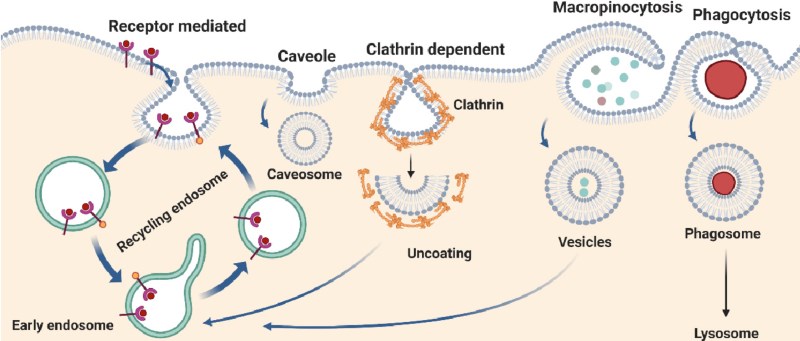Hi-Affi™ pH-Sensitive Dye for Internalization Detection
For compounds against intracellular targets, internalization ability is one crucial characteristic, as they will rely on this process to confer their intended effects. Particularly, antibodies with internalization potencies can also act as excellent vehicles for targeted delivery of drugs, toxins, enzymes or DNA into cells for various therapeutic/diagnostic applications, e.g. ADCs. Empowered by state-of-the-art techniques and rich experience, scientists in Creative Biolabs has established a versatile platform for internalization assessment. Here we are glad to introduce Hi-Affi™ pH-sensitive dye assay services for compound internalization profiling to worldwide researchers.
Introduction to Endocytosis
In the process of endocytosis, certain agents can transport themselves from extracellular environment into cytosol. Endocytosis can be classified into three categories: phagocytosis, pinocytosis, and receptor-mediated endocytosis. In phagocytosis, the cell's plasma membrane wraps a macromolecule or even an entire cell and buds off to form a food vacuole or phagosome. In pinocytosis, the cell swallows drops of fluid by forming vesicles that are smaller than the phagosomes formed in phagocytosis. Both phagocytosis and pinocytosis are non-specific processes in which the cell takes in whatever solutes it envelops.
 Fig.1 Different pathways of endocytosis.1, 2
Fig.1 Different pathways of endocytosis.1, 2
Unlike phagocytosis and pinocytosis, receptor-mediated endocytosis is an extremely selective process of the cell. This specificity is mediated by receptors located on the cell membrane. Extracellular macromolecules (ligands) bind to particular cell surface receptors that are concentrated in clathrin-coated pits. These pits bud from the membrane to form small clathrin-coated vesicles wrapping the receptors and their bound macromolecules (ligands). The clathrin-coated vesicles then fuse with early endosomes, in which the contents are classified and transported to the lysosomes or recycled to the plasma membrane.
Hi-Affi™ pH Dye for Internalization Detection
Creative Biolabs now integrates a specialty pH-sensitive dye technique for internalization detection of diverse compounds. This particular dye is not fluorescent at neutral pH but will emit high fluorescence signals at acidic pH. As is known, there exists a clear difference in pH between body fluid (neutral) and cellular endosomes/lysosomal vesicles (acidic). Hence, this pH reactive dye conjugated to compound of interest can be used for dynamic detection of internalization activities, which can be easily monitored and analyzed using flow cytometry or fluorescent microscopy.
Unique Advantages of Hi-Affi™ pH Dye
- Convenient and no-wash
- Flexible conjugation (amine-reactive dye and thiol-reactive dye)
- Suitable for studying both receptor-mediated and non-receptor-mediated internalization
- High throughput and high accuracy
- Real-time measurement
Popular Products at Creative Biolabs
In addition, we have developed a diverse range of powerful pH-sensitive dye products specifically designed for studying antibody endocytosis and internalization. These innovative dyes exhibit minimal fluorescence at neutral extracellular pH but demonstrate a significant increase in fluorescence upon entering the acidic environment of endosomes and lysosomes. This unique property allows for highly sensitive and specific detection of antibody internalization, minimizing background noise and providing researchers with valuable insights into the cellular uptake and trafficking of therapeutic antibodies. Listed below are several popular products:
| CAT | Products Name | Assay Measures |
|---|---|---|
| DR-LX049 | Hi-Affi™ pH-Sensitive Dye, Intracellular pH Indicator-Green AM | Fluorescence |
| DR-LX050 | Hi-Affi™ pH-Sensitive Dye, Intracellular pH Indicator-Red AM | Fluorescence |
| DR-LX051 | Hi-Affi™ pH-Sensitive Dye, Endocytosis Indicator-Red Dextran | Fluorescence |
| DR-LX052 | Hi-Affi™ pH-Sensitive Dye, Endocytosis Indicator- Green Dextran | Fluorescence |
| DR-LX053 | Hi-Affi™ pH-Sensitive Dye, Epidermal Growth Factor (EGF) Conjugate-Red | Fluorescence |
| DR-LX054 | Hi-Affi™ pH-Sensitive Dye, Epidermal Growth Factor (EGF) Conjugate-Green | Fluorescence |
| DR-LX055 | Hi-Affi™ pH-Sensitive Dye, Transferrin Conjugate-Red | Fluorescence |
| DR-LX056 | Hi-Affi™ pH-Sensitive Dye, Red STP Ester (amine-reactive)-S | Fluorescence |
Creative Biolabs now offers one-stop, custom-oriented internalization detection service using multiple strategies, from which you can always find the best match for your specific candidate. Please don't hesitate to contact us for more information.
Related Products:
Hi-Affi™ pH-Sensitive Dye Reagents
References
- Pathak, Chandramani, et al. "Insights of endocytosis signaling in health and disease." International journal of molecular sciences 24.3 (2023): 2971.
- under Open Access License CC BY 4.0, without modification.
For Research Use Only.
